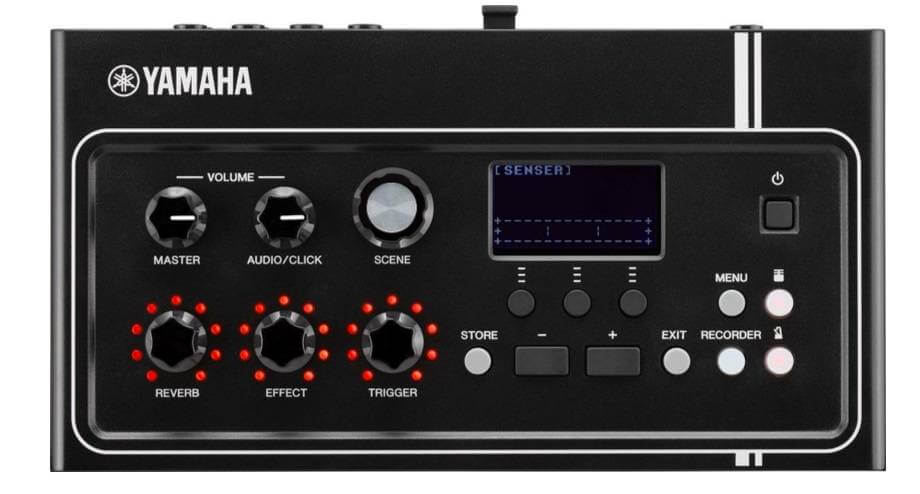
The common thought is that while home studio setups are great for singer/songwriters and doing small demo projects, you need to haul all your drums and percussion gear to a “real” studio for proper recording. As evidenced by the small, yet powerful, Yamaha EAD10, that’s not true at all.
What the EAD10 aims to accomplish is giving the user an easy, affordable way to mic an entire drum kit, add fx, and output that to a DAW in a very seamless manner. In our tests, we purposefully decided to use the unit in a home studio setting to see how well the unit worked without the aid of precision mic setups and a commercial board and engineer on hand. And we must say, the results are striking. For starters, getting up and running is a snap. The main unit just sits next to your kit, and the kick sensor attaches easily to, well…exactly where you’d expect. The menu-based navigation is usually a turn off (we prefer knob-per-function capabilities, especially on things like synths), but this was easy to dig into without being intimidating.
The mic/trigger combo just simply works. It works easily. It works well. And it sounds great with little effort. Even if you’ve never mic’d up a kit before, you’ll be getting useful drum tracks in no time, which is the entire purpose. We hate it when manufacturers can’t even deliver on the most basic premise of their gear, but thankfully that’s not the case with the EAD10.
We found best results just using the default settings, and punching in smaller and smaller amounts of some of the onboard reverb and compression fx to round out the overall tone. Seriously, getting a stereo drum track without overhead mics dangling above you and kick mics getting knocked over due to overzealous playing was a welcome relief. To be honest, we left the compressor on for the duration of our testing because it just seemed to glue everything together. Of course, you don’t have to use anything on-board, you can take the raw sound that the unit picks up and shoot that straight into your DAW of choice for later processing and editing. It’s nice to have options and not be locked into one setting.
One of the nice bonuses that you’ll get with this package is a useful app for your phone that allows you to play back to pre-recorded tracks and clicks, which can make YouTube performance clips a whole lot easier. It’s even got some smart tempo recognition that will come in handy for syncing things up properly.
The bottom line is this unit does what you’d need it to: namely, record a drum kit, in stereo, in CD-quality resolution, without the need for costly commercial studio time and setup headaches. It’s quite a technical achievement, and for bands on a budget who never thought of recording their entire album on their own, including DRUMS, this one’s for you.
The only two things we’d like to see included in the future are a snare trigger (to be fair, this is already available, just not included in the basic package), and perhaps more intuitive MIDI implementation. The unit does send MIDI and audio at the same time, but it’s not easy to find unless you go menu-diving. In fact, we missed it until Yamaha informed us how to set it up. In case you’re curious, here’s how: out of the USB, press Menu/Utility/General then arrow down three pages and select USB to Host/+ key to switch to “Audio and MIDI”.
But for $499, we can’t recommend it highly enough. We just have to be nitpicky, or else we wouldn’t be doing our jobs 🙂
PROS:
easy to setup, great audio capture, many trigger options, multiple on-board output/DAW options.
CONS:
DT50S snare trigger not included in basic package, MIDI capabilities are difficult to find in the menu system.
STREET PRICE:
$499